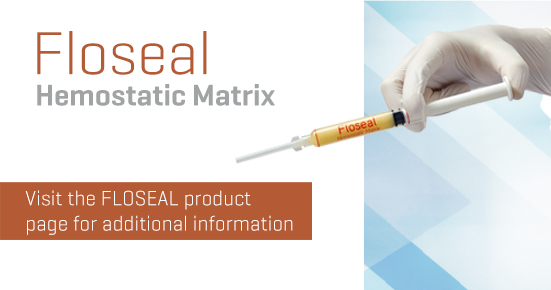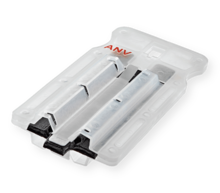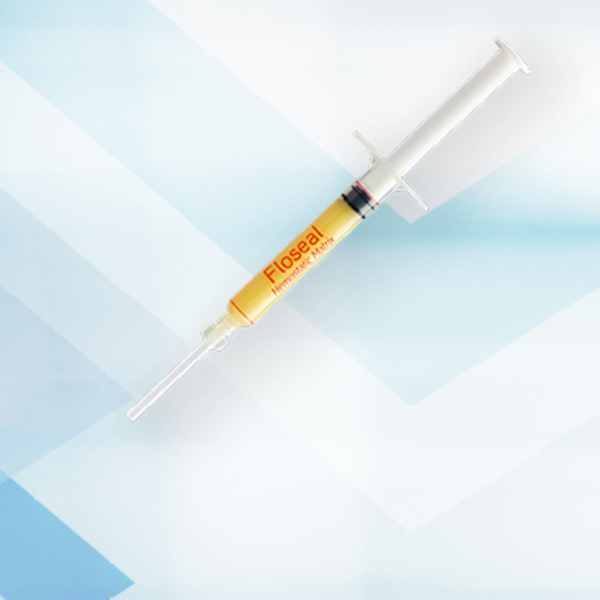Bariatric Surgery
Bariatric surgeries come with a special set of challenges. Baxter's hemostat, sealant and tissue repair products have the strength needed to address leakage, bleeding and access issues in every bariatric procedure. Safer surgery and less time in the operating room means faster recovery for each patient.
Each bariatric procedure provides unique challenges that can cause complications for the healing process. Here are just a few examples.
Sleeve Gastrectomy
Success of sleeve gastrectomies, like other bariatric procedures, relies on appropriate healing. PERI-STRIPS quickly reinforces the staple line and helps reduce the risk of leaks and bleeds that can occur during surgery1.
Roux-en-Y
Roux-en-Y procedures are often conducted on the most obese patients, further elevating the need to get out of the OR quickly. TISSEEL, Baxter's fibrin sealant, controls oozing bleeds during laparoscopic surgery and can be sprayed on the staple line to decrease post operative bleeding2.

Duodenal Switch
Duodenal switch procedures can often result in more complications than other bariatric surgeries. FLOSEAL, Baxter's flowable hemostat, can be trusted to stop many types of bleeding3.
Portfolio of Products
Indications and Important Risk Information
PERI-STRIPS DRY WITH VERITAS INDICATIONS FOR USE
PERI-STRIPS DRY with VERITAS Collagen Matrix (PSDV) Reinforcement is intended for use as a prosthesis for the surgical repair of soft tissue deficiencies using surgical staplers when staple line reinforcement is needed.
(Circular reinforcement only) PSDV reinforcement can be used for reinforcement of staple lines during gastric, bariatric, and small bowel procedures.
(Linear reinforcement only) PSDV Reinforcement can be used for reinforcement of staple lines during lung and bronchus resections and during bariatric surgical procedures, and during gastric, small bowel, mesentery, colon, and colorectal procedures.
PERI-STRIPS DRY WITH VERITAS IMPORTANT RISK INFORMATION
The use of PSDV Reinforcement is contraindicated in patients with known sensitivity to bovine or acrylic material.
Do not re-sterilize. Resterilization may cause changes to the tissue and negatively impact functionality of the device.
Discard all open unused components. Do not use product if there is damage to the pouch or seals.
Ensure the staple line is completely covered with the buttress or inadequate coverage after firing may result.
Do not use PSDV Reinforcement if the product has been exposed (1) to solutions above room temperature, (2) to chemicals, antibiotics, or other substances other than specifically addressed in the instructions, (3) or if heat indicator has been activated.
Use care when removing loading unit components from the stapler to prevent buttress dislodgement.
Do not get the buttress wet before applying Gel, or the buttress may not adhere to the stapler properly.
Ensure the anvil and cartridge sides of the loading unit are on the corresponding stapler jaws or the buttress may not adhere to the stapler properly. The cartridge and anvil sides of the PSDV Reinforcement loading unit differ; substitution of one side for the other may interfere with alignment and adherence of the buttress strips.
Final tissue compression, including PSDV Reinforcement, must meet the range specified by the stapler manufacturer; this is especially important if staple firings are overlapped. PSDV Reinforcement increases the total thickness of the area stapled by 0.4 mm – 1.2 mm (0.016” – 0.048”).
(Circular reinforcement only) Cartridge cones may be used for entry into the surgical site on the cartridge side of the stapler during endoscopic surgery. Before completion of surgery be sure to remove the cartridge cone from the surgical site.
Rx Only. For safe and proper use of this device, refer to the Instructions for Use.
PSDV Full Instructions for Use:
TISSEEL [Fibrin Sealant] Indications
Hemostasis: TISSEEL is a fibrin sealant indicated for use as an adjunct to hemostasis in adult and pediatric patients (> 1 month of age) undergoing surgery when control of bleeding by conventional surgical techniques (such as suture, ligature, and cautery) is ineffective or impractical. TISSEEL is effective in heparinized patients.
Sealing: TISSEEL is a fibrin sealant indicated as an adjunct to standard surgical techniques (such as suture and ligature) to prevent leakage from colonic anastomoses following the reversal of temporary colostomies.
Important Risk Information for TISSEEL [Fibrin Sealant]
For Topical Use Only. Do not inject TISSEEL directly into the circulatory system or into highly vascularized tissue. Intravascular application of TISSEEL can lead to intravascular coagulation, can result in life- threatening thromboembolic events, and can increase the likelihood and severity of acute hypersensitivity reactions in susceptible patients. To minimize the risk of intravascular application, exercise caution when using TISSEEL in surgery.
Do not use TISSEEL in individuals with a known hypersensitivity to aprotinin.
Do not use TISSEEL for treatment of severe or brisk arterial or venous bleeding. In these situations, TISSEEL will be washed away in the flow of blood before hemostasis can be attained.
Do not spray TISSSEEL where the minimum recommended distance from the applicator tip to the target site cannot be assured.
Hypersensitivity or allergic/anaphylactoid reactions can occur with the use of TISSEEL. Such reactions may especially be seen if TISSEEL is applied repeatedly over time or in the same setting, or if systemic aprotinin has been administered previously.
Aprotonin is known to be associated with anaphylactic reactions. Even in the case of strict local application of aprotinin, there is a risk of anaphylactic reactions to aprotinin, particularly in the case of previous exposure.
Discontinue administration of TISSEEL in the event of hypersensitivity reactions. Remove remaining product from the application site.
Air or gas embolism has occurred when fibrin sealant was administered using pressurized gas. This can occur if a spray device is used at higher than recommended pressures and in closer than recommended proximity to the tissue surface.
When using the EASYSPRAY device, or an equivalent spray device for open surgical procedures cleared by FDA, TISSEEL must not be sprayed in enclosed body areas and must be sprayed onto only visible application sites.
TISSEEL is denatured when exposing to solutions containing alcohol, iodine or heavy metals. If any of these substances have been used to clean the wound area, the area must be thoroughly rinsed before the application of TISSEEL.
Apply TISSEEL as a thin layer by dripping or spraying using cannula or spray set. Excess clot thickness can negatively interfere with wound healing.
The safety and effectiveness of TISSEEL used alone or in combination with biocompatible carriers in neurosurgical procedures or other surgeries involving confined spaces have not been evaluated; its use in this setting is not FDA approved.
TISSEEL is made from human plasma. It may carry a risk of transmitting infectious agents, e.g., viruses, the variant Creutzfeldt-Jakob disease (vCJD) agent and, theoretically, the Creutzfeldt-Jakob disease (CJD) agent.
Please see accompanying full Prescribing Information
FLOSEAL Hemostatic Matrix Indication
FLOSEAL Matrix is indicated in surgical procedures (other than ophthalmic) as an adjunct to hemostasis when control of bleeding by ligature or conventional procedures is ineffective or impractical.
Full important risk information
Do not inject or compress FLOSEAL Matrix into blood vessels. Do not apply FLOSEAL Matrix in the absence of active blood flow, e.g., while the vessel is clamped or bypassed, as extensive intravascular clotting and even death may result.
Do not use FLOSEAL Matrix in patients with known allergies to materials of bovine origin. Do not use FLOSEAL Matrix in the closure of skin incisions because it may interfere with the healing of the skin edges.
FLOSEAL Matrix contains Thrombin made from human plasma. It may carry a risk of transmitting infectious agents, e.g., viruses, and theoretically, the Creutzfeldt-Jakob disease (CJD) agent.
FLOSEAL Matrix is not intended as a substitute for meticulous surgical technique and the proper application of ligatures or other conventional procedures for hemostasis.
Excess FLOSEAL Matrix (material not incorporated in the hemostatic clot) should always be removed by gentle irrigation from the site of application.
FLOSEAL Matrix swells by approximately 10% to 20% after product is applied. Maximum swell volume is achieved within about 10 minutes.
The safety and effectiveness of FLOSEAL Matrix has not been established in children under 2 years of age and pregnant women.
Do not use air to remove residual FLOSEAL Matrix from Applicator tip. The Applicator tips should not be cut. Do not use FLOSEAL Matrix on bone surfaces where adhesives, such as methylmethacrylate or other acrylic adhesives, will be required to attach a prosthetic device.
Rx Only. For safe and proper use of this device, refer to the full Instructions for Use.
FLOSEAL Full Instructions for Use:


